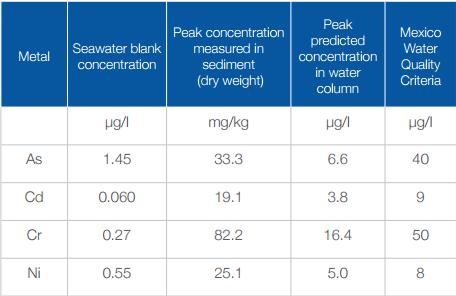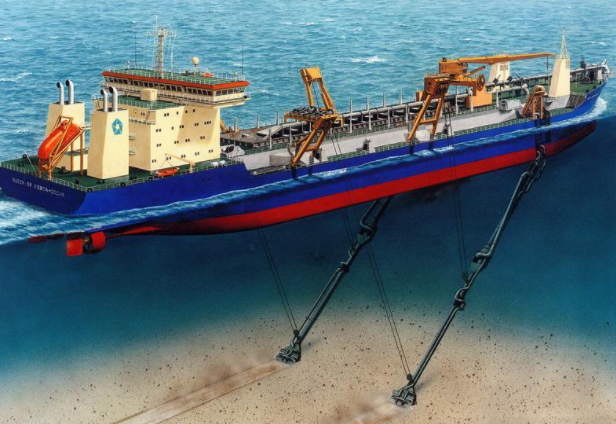A group led by a small foreign non-governmental organization, AIDA, is coordinating a highly deceptive public relations campaign to manipulate residents of Baja California Sur (BCS) into opposing the proposed “Don Diego” marine phosphate operation in Mexico. The environmentalists are deliberately misinforming the public about key aspects of the project, and making wildly exaggerated claims, in an effort to scare citizens into believing the project will be a disaster for the environment.
In addition to being dishonest and unethical, the campaign threatens the health and well-being of many Mexicans, and ironically, it also threatens the environment.
Developing Don Diego will support President Peña Nieto’s national Crusade Against Hunger, which aims to eliminate food poverty, in part, by increasing access to affordable domestic fertilizers. Over 53 million Mexicans live in poverty and have difficulty meeting basic nutritional needs. Sadly, approximately 8,500 citizens die each year from malnutrition, and malnutrition amongst children is especially widespread. Because the Don Diego project offers a low cost, secure source of phosphate, the project can increase food production while lowering food production costs and help lift millions of Mexicans out of food poverty.
No mine is good for the environment. Yet, the human race depends on mining to survive, so we try to extract resources in a manner that imposes the lowest environmental costs. Don Diego represents a dramatic leap forward in lowering the environmental costs associated with phosphate mining (see here). Because the environmental costs associated with Don Diego are lower than those related to terrestrial phosphate operations, developing Don Diego will yield a net benefit to the global environment as Don Diego supplants production from mines that are more harmful.
The Don Diego Project
Don Diego is a proposed marine phosphate dredging operation sponsored by the Mexican firm, Altos Hornos de México, and the American company, Odyssey Marine Exploration. The concession is situated roughly 35 kilometers off the coast of Baja California Sur. The project involves vacuuming phosphate sands from the bottom of the ocean. It is a simple, mechanical process that does not add any chemicals or other foreign matter to the marine environment.
Dredging operations identical to Don Diego have been undertaken for decades, and the environmental impact of these operations has been carefully recorded in academic studies. These studies have shown that the environmental impact is limited when best practices are followed. Dredging operations are used to extract aggregates in Europe and Asia, to extract diamonds in Africa, and for land reclamation, harbor, canal, and beach improvements all over the world.
Dredging for phosphate sands will be far less damaging to the environment than the land-based operations it can replace. Dredging operations require less energy, generate a smaller carbon footprint, use less land, less freshwater, and perhaps most significantly, require no overburden removal, and thus involve much less processing than terrestrial extraction operations. A recent environmental study confirmed the relative advantages of seabed mining versus terrestrial mining.
Don Diego is strategically important to Mexico. Currently the country imports 80 percent of the fertilizer it consumes. Those imports, however, are expensive, so many Mexican farmers don’t use fertilizers or under-fertilize. According to this presentation given by Mexican state-owned oil company, Pemex, to catch up with world productivity metrics, Mexico needs to double its fertilizer consumption.
The benefits from developing Don Diego are manifold. The concession represents a large, relatively inexpensive source of the key fertilizer nutrient – phosphate. A large, secure domestic source of the strategic phosphate resource would make Mexico less vulnerable to supply shocks, price spikes, and riots. It would make phosphate fertilizers more affordable for farmers, and it would allow the country to stop importing expensive phosphate illegally from Western Sahara. It could provide Mexico, and BCS in particular, almost ten billion pesos in royalties over the project’s lifetime. It could also help to create hundreds, and perhaps thousands of jobs in Mexico within the phosphate and fertilizer supply chain. Furthermore, the feedstock provided by this project would help strengthen Mexico’s plans to make the country a globally significant hub for fertilizer products.
But the government’s plan to boost fertilizer production from 2015 seems not to take into account the situation of the ore from rock phosphates and whose scarcity, both in Mexico and in the world, begins to alarm experts. Today we have to import. It is very focused on Morocco and the Western Sahara is home to the largest amount of phosphorus in the world. There’s the rock phosphate used as fertilizer that contains all elements for fertilizers. The shortage is so severe as global warming. We are not aware of the problem. The resource is finite, “says Jesús Valdés, researcher at the Institute of Chemistry of the National Autonomous University of Mexico, for this report Link
Don’t Let the Facts Get in the Way of a Good Story
Because the facts favor the development of Don Diego, environmentalists are forced to fabricate stories in a clumsy attempt to manipulate Mexican citizens to oppose the operation. The lack of honesty and integrity, the willful bending of the truth, is apparent from the very first sentence in AIDA’s early propaganda directed against the proposed Don Diego marine phosphate mine, authored by Haydee Rodriguez.
A project to mine 225,000 acres of seabed in Baja California’s San Ignacio lagoon threatens the myriad sea life of the area, writes Haydée Rodríguez: not just Gray whales but Blues, Humpbacks and Loggerhead turtles, from noise, disturbance and radioactive releases.
There are a number of glaring inaccuracies in this sentence, but we will concentrate on two in particular which represent egregious misstatements of fact. First, the project is not in the sensitive San Ignacio lagoon. In fact, it does not come close to the San Ignacio lagoon (or any lagoon for that matter). The project’s Non-Technical Summary indicates that, “The minimum distance from the coast is 22.2 km.” Not only will the dredging take place far from the lagoon, but its impact will be confined to within two to four kilometers from the operation according to empirical data and modeling in the environmental application. Thus, there will be absolutely no impact along the coast or within the lagoons as Ms. Rodriguez suggests. The gray whales’ nursing grounds are under no threat from the project.
The second misleading point is found in Ms. Rodriguez’s claim that project will mine 225,000 acres. The project’s Non-Technical Summary clearly states that Don Diego will mine 1 square km per year (247 acres). Over the 50-year mine life, the total mined area would equal approximately 12,350 acres, or 5.4% of the area that Ms. Rodriguez represented in her article. In other articles, AIDA variously refers to the mine as extracting 350 million tons of phosphate sands (the correct number is approximately 150 million tons) and mining 91,000 hectares (when slightly less than 5,000 hectares will be mined per the application). Though AIDA has been warned about their inaccurate claims, they continued to publish them, demonstrating a willful intent to deceive Mexico’s people. Incidentally, the size of the Don Diego operation indicates a small mining footprint relative to land-based mines.
AIDA’s sensationalism has a purpose. The organization aims to mislead the audience into believing the project is larger than has been proposed, so to generate concern over the massive scale of the operation. The facts contained in the environmental filing and Non-Technical Summary are inconvenient to AIDA, so the organization makes up figures which better suit its purposes.
AIDA and other opposition groups regularly promote the fact that Don Diego would be the first offshore phosphate extraction operation authorized in Mexico, or anywhere. AIDA writes, “The comments show that the Don Diego project, the first of its type in the region, could cause serious environmental damage…” link Another article asserts, “offshore phosphate mining has never been done before anywhere the world…” link AIDA’s aim is to scare Mexicans, their politicians, and regulators into thinking that the project is experimental, dangerous, and that its impact cannot be predicted.
Yet, the facts stand in stark contrast to the misdirection offered by these environmental groups. Marine phosphate dredging operations are not novel. In fact, the Mexican government operated a marine phosphate dredging operation directly within the Bay of Magdalena in the 1980s. Mosaic operates freshwater phosphate dredging operations today. In addition, to suggest that phosphate dredging is any different from the tens of thousands of sand dredging or aggregate dredging operations that take place all over the world is highly misleading. The processes and equipment involved in these operations are virtually identical to those proposed for Don Diego. The standards, models, and empirical data that have been developed around these operations over decades have guided and informed the Don Diego environmental submission. As such, the outcome of the work is highly predictable.
In a number of publications, AIDA and other groups allege that the extraction operation would threaten whale populations. In this article, Ms. Rodriguez says, “The noise could jeopardize the survival of the whales by causing changes in their behavior and migration route, and it could also disrupt mothers feeding their calves.” Yet the idea that a single, slow moving dredging vessel operating 22 kilometers away would jeopardize the survival of any whale is an outlandish statement with no basis in fact. More objective scientific work supports the limited nature of impact from dredging on marine mammals. Furthermore, the type of dredging vessel used for Don Diego has been employed in Mexico, and all over the world, for decades. Dragamex alone has conducted over 220 dredging projects in the country. Yet we could not find a single recorded incident where a dredging vessel threatened the survival of a whale.
Gray whales are far more threatened by fast-moving whale watching boats, fishing vessels, and tankers that operate in close proximity to the whales, than a single, slow moving dredge operating 22 km away (at its closest point). Note that the project is not close to the lagoons where the whales feed their young, or near their migratory path which is very close to shore.
In a number of articles, AIDA asserts that toxins in the plume generated in the Don Diego operation could threaten fish and the people who eat fish. “These toxins may be consumed by fish that then arrive on our tables, making phosphate mining a potential source of radioactive contamination.” Yet again, a couple of facts are inconvenient to the author’s point.
First, the toxins to which Ms. Rodriguez refers are naturally occurring in the sediment, and do not pose a risk in the peak concentrations demonstrated in discharge models cited in the Don Diego environmental application. Second, the sediment is discharged by pipe to the bottom of the ocean, meaning that the plume remains below the light-fed layer where phytoplankton live and where fish feed. Third, the mining footprint is specifically known for its lack of sea life. It overlaps no fishing concessions, and fishermen avoid it because of its lack of sea life – calling it the “mud pits.” The scarcity of fish within the mining footprint may be due to the high concentrations of phosphate on the sea floor, as high concentrations are thought to be inhospitable to life.
While the dredging process causes turbidity which liberates sediments from the bottom of the ocean in a plume, the heavy metals quickly fall out of the solution because of their relative weight. The models contained in the environmental application, and decades of empirical data, show this fact to be true. To put this threat into context, heavy storms in the area regularly cause turbidity containing the same heavy metals on a scale that would make the Don Diego operation completely inconsequential by comparison.
In another article, AIDA says, “the project threatens to damage seriously and irreversibly the marine environment, living conditions of wildlife it houses and livelihoods of communities that depend on tourism and fishing in the area.” link
Yet, tens of millions of dollars have been spent on studies over the last three decades which show that environmental damage from dredging is nether serious, nor irreversible. In fact, the studies show that recolonization can be rapid and that the operations can have a positive impact on the marine environment in some cases by causing a more varied bathymetry. Further, AIDA would have to explain how one dredging vessel operating 30 kilometers out to sea is a threat to tourism or to fishing. Dredging projects have been undertaken in Mexico, and all over the globe, for 30 years without impacting tourism or fishing operations. Don Diego will operate outside all fishing concessions. AIDA’s statement is completely without merit.
AIDA and others have also claimed that the project would pose a grave risk to the local loggerhead turtle population, and could exacerbate a conflict between the United States and Mexico which, “would have serious socio-economic impacts not only on the State of BCS, but also in the rest of the country.” link
Again, while the statements sound very ominous, they don’t fit the facts very well. For background, the US organization NOAA issued a negative certification in relation to Mexico’s turtle bycatch program because of the fishing bycatch of turtles in the Gulf of Ulloa. Though dredging has taken place in Mexico and in the US for decades, the NOAA complaint does not mention dredging because dredging techniques and operations have been refined to such an extent that turtle entrainment is no longer a significant problem.
Moreover, the project is not located in the shallow, warm waters that attract turtles. Don Diego is between 60-80 meters deep, and its high phosphate content makes the area inhospitable to benthic organisms which would provide a food source for turtles. Few or no turtles are likely to inhabit the seafloor where Don Diego dredging will take place. Even if there were turtles present, the dredge head will be equipped with a number of protective mechanisms to prevent turtles from becoming entrained. These protection devices have helped to reduce turtle takes by over ten times since they were introduced in the early-1990s.
Our thoughts on sea turtles have now been confirmed by a unanimous, 11-0 ruling from the TFJA, which overruled Semarnat’s refusal on the grounds of sea turtle impact.
A Misuse of the Precautionary Principle
The precautionary principle is, however, a very useful one for consumer activists precisely because it prevents scientific debate. The burden of evidence and proof is taken away from those who make unjustified and often whimsical claims placed on the scientific community which, because it proceeds logically and rationally, is often powerless to respond. This is what makes the principle so dangerous. It generates a quasi-religious bigotry which history should have has taught us to fear. Its inherent irrationality renders it unsustainable. Link
AIDA, and others who have opposed the Don Diego project, wield the Precautionary Principle like a weapon. It is their “ace in the hole,” that can crush any project, no matter how benign its environmental impact or beneficial its effects on humanity. AIDA cites Mexico’s international obligation to abide by the Principle, but applying the Principle is a thoroughly subjective exercise and it is not at all clear that Principle would prohibit Don Diego’s development. What is clear is that Mexico is currently violating the international ruling which prohibits the importation of phosphate from Western Sahara. It is also clear that Don Diego could replace rock from Western Sahara and put Mexico back in compliance with international law. This fact seems to have escaped the notice of AIDA’s environmental lawyers, however.
We must tread lightly with respect to the Precautionary Principle. The strong form of the Principle, which AIDA advocates, is highly controversial. In the past, its adoption has sometimes led to large scale human death and suffering while stymieing innovation and progress.
It is virtually impossible to achieve “scientific certainty” in proving a negative (that the project will do no harm) as the strong form of the Precautionary Principle demands. As many have noted, this is an unreasonably high standard, and setting it in such a manner can be extremely dangerous. Applying the strong version of the Precautionary Standard throughout history would have necessarily prevented the development of most common medicines, power generation technologies, vaccines, and many other life-giving innovations. Indeed, the application of a strong version of the Precautionary Principle is widely believed to have caused tens of millions of deaths by restricting access to technological innovations such as DDT and Golden Rice (amongst others).
A thoughtful and comprehensive application of the Precautionary Principle in the case of Don Diego would acknowledge that though scientific certainty with respect to environmental costs cannot be achieved, we have thirty-plus years of empirical data which shows that the activity can be undertaken with relatively low risk to the environment. The environmental risks associated with the Don Diego extraction project, based on scientific data provided in the MIA, and empirical data from similar projects, are neither serious nor irreversible.
Any analysis relying on the Precautionary Principle must, by definition, also endeavor to comprehend the risks of NOT undertaking the subject activity. While science and data demonstrate that the risks of moving forward with Don Diego are limited, the risks of not undertaking the project appear to be serious to human health, and potentially irreversible. Denying Mexico’s population the technology to access inexpensive phosphate risks thousands of lives each year, and may cause suffering in tens of millions more. It subjects the country to the risks of further phosphate market instability. It also may result in more pronounced environmental damage in places such as Florida, and Peru. Finally, it encourages a continued reliance on the illegal importation of phosphate from Moroccan controlled Western Sahara, as well as the continued subjugation of the people of Western Sahara.
The chronic obstruction of so many economic endeavors is a symptom of deeper problems in the environmental movement. Environmentalists tend to live in a fantasy world, where some unattainable perfection is always the enemy of the good. What was once reasonable conservation has become for many the pseudo-religion of environmentalism, where Luddite obstruction is the default position, and no environmental benefit, no matter how small, is ever too costly. Link
AIDA Owes Mexico an Apology
The shame in this manipulative and corrupt campaign against Don Diego is that it threatens not only millions in Mexico who suffer from malnutrition, but that it also represents a genuine threat to the environment. Seabed mining is far less impactful to the environment than terrestrial mining. Thus, opposing a relatively nonthreatening project such as Don Diego would, if successful, create higher environmental costs for the global environment by causing a continued reliance on production from terrestrial sources.
This is not to say that Don Diego has no environmental impact. Any extraction operation will cause damage. The project will impact the seafloor within the mined area and any small organisms that reside there, and it will temporarily create a plume that contains naturally-occurring elements from the seabed, but that is contained to a relatively small footprint. All of this is well-anticipated, and because the immediate benthic ecosystem is relatively insensitive (i.e. it is not on a coral reef, or in a fish spawning ground), the associated costs are not high. Outside the benthos of the mining footprint, the environmental impact will be limited, and the overall impact will certainly be less costly than land-based alternatives.
Environmentalists such as AIDA do more harm than good with their sensationalist, manipulative, and inaccurate claims. AIDA’s campaign of lies and distortion is demeaning to the people of Baja California Sur, and to Mexico more generally. Does AIDA truly believe that it can use the residents of BCS in such a manner without repercussion? Are environmentalists never held accountable?
This campaign is an embarrassment to AIDA, and the organization owes BCS citizens an apology. This is not simply another case of narrow-minded environmentalists imposing their misguided, but well-intended agenda on others. AIDA’s blatant and deliberate deception has crossed a line. The truth was readily available, but AIDA chose to ignore the facts. Moreover, AIDA’s campaign of misinformation could cost Mexican lives, jobs, and billions in pesos. Their antics will have a lasting impact on future environmental campaigns in Mexico. How can the public trust these groups when they’ve shown such a willingness to abuse that trust?
Why would AIDA tell so many blatant lies about Don Diego when the project that can help so many Mexicans and the environment? AIDA owes Mexico nothing, and there are reports that a large international fertilizer company is funding groups, including NGOs, to stop the development of Don Diego. This fertilizer company wants to prevent a major new competitor from emerging in the fertilizer market, and it wants to keep Mexico and North America, dependent on outside sources for fertilizers. It likely found an accomplice in AIDA, a company that was willing to sell its soul and overlook moral and ethical obligations in an effort to keep Mexico poor and hungry while keeping its donor wealthy and protected.









 New Zealand recently joined the list of countries that have given environmental and regulatory clearance for seabed mining to occur within their Exclusive Economic Zones(EEZs). Trans Tasman Resources was
New Zealand recently joined the list of countries that have given environmental and regulatory clearance for seabed mining to occur within their Exclusive Economic Zones(EEZs). Trans Tasman Resources was